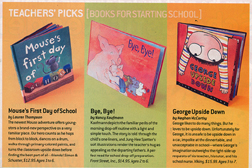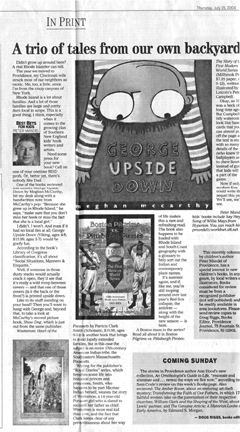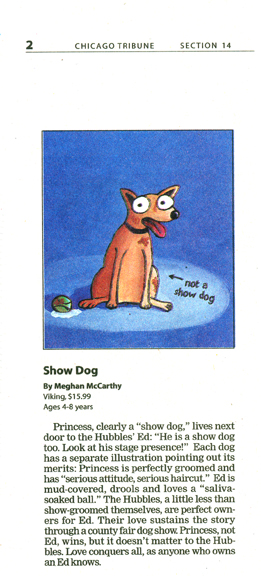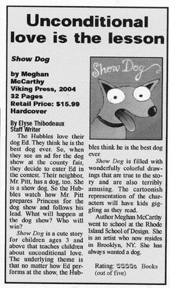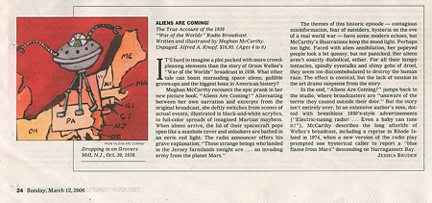
 |
||||
|
|
||||
|
Publishers Weekly - Loopy and bright, first-time author/artist McCarthy's George "likes to do many things./ But he loves to be upside down." It sometimes gets him into trouble, however, as do the fantasy scenarios he offers by way of excuses. "George, stop spilling your food," says his mother as he eats his dinner upside down. "I'm a dog!" he answers. His teacher, tutor, the school nurse and the principal can't change George's mind, but when all of the adults try life upside down themselves, George decides he will "do something new and it doesn't get him into trouble. Well... not as much." The closing spread shows him donning a superhero costume with a capital G on the chest; he "flies" upright but threatens a terrified-looking cat ("Super George to the Rescue!" reads the speech bubble). McCarthy's googly-eyed characters look designed for animation. Beginning with the lively endpapers, she often divides the action into comic book-style panels overflowing with surprising perspectives. When George waits in the hall for the principal, for example, readers see the world through George's eyes-as he watches the feet of five people go by, upside down. Then the perspective shifts, as readers see George draw closer in each frame to the principal's door, where the quintet is attempting life upside down. McCarthy's humor is right on target for mischievous younger readers. Ages 3-7. (Mar.) Copyright 2002 Cahners Business Information. Kirkus Reviews - Bright primary colors and energetic design enliven this portrayal of a little boy, who, in typically perverse youngster fashion, likes to do everything upside down. That's fine while he's playing, but his parents wish he would sit right-side up in the car and at the dinner table. His teacher sends him to a tutor, the tutor sends him to the nurse, and the nurse sends him to the principal, who comes up with a creative solution: George is made to wait outside the principal's office until his curiosity gets the better of him; when he finally peeks in, he sees his parents, teacher, nurse, tutor, and principal, all standing on their heads. Now that being upside down isn't so much of a novelty, George turns his attention to a new project that gets him in a little less trouble: becoming Super George. McCarthy's picture-book debut features riotous pictures of inverted George going about his daily activities (yo-yoing, eating dinner, etc.) with his feet in the air. One hilarious spread, from George's point of view, shows feet that turn out to belong to his parents, teacher, etc., walking by while George is waiting for the principal. The flat, bold illustrations feature comically stylized people with exaggerated googly eyes; the simple facial expressions are marvelously apt at conveying George's mischievousness and the adults' worried censure. Beware teachers and parents: readers may be inspired to try some of George's tricks themselves. (Picture book. 3-7) Booklist - PreS-Gr. 2. The eye-popping cover showing George hanging upside down lets kids know right away that he's no average child. George loves to be upside down--reading, painting, playing the trumpet, even dreaming! But there are times when George needs to be right side up--in the car, at dinnertime, and especially at school. His teacher sends him to the tutor, who sends him to the nurse, who sends him to the principal's office--where George finds all the adults upside down. His discovery prompts him to find something else to do when he returns to class--he becomes Super George "to the rescue," complete with Superman outfit. Kids may not catch the irony involved, but they will like George's independent spirit, which is highlighted by the cartoonlike illustrations in flat, bright colors The bold colors, broad strokes, and bug-eyed figures that dominate the spreads turn the topsy-turvy story into child-size comedy. Julie Cummins Copyright © American Library Association. All rights reserved George was recomended by Parent and Child Magazine
Dad's Contribution to the Bookselling Effort!
One of the books reviewed this month, George Upside Down by Meghan McCarthy, hit my desk along with a handwritten note from McCarthy's pop: "Because she grew up in Rhode Island," he says, "make sure that you don't miss her book or miss the fact that she is a local girl." Oh boy! Dad did it this time! I had a good laugh! Thankfully, my book was not disparaged... I didn't. I won't. And even if it had no local ties at all, George Upside Down (Viking, ages 4-8, $15.99, ages 3-7) would be goofy fun. According to the book's Library of Congress classification, it's all about "Social Situations, Manners & Etiquette." Well, if someone in those dusty stacks would actually crack it open, they'd see that it's really a wild romp between covers -- and that one of those covers (is it the back or the front?) is printed upside down. Like to do stuff standing on your head? Then you'll want to hang with George and, beyond that, to take a look at McCarthy's second picture book, Show Dog, which is just out from the same publisher.
Chicago Tribune - George is a gravity rebel. You think you couldn't watch TV upside down? George can. There is, however, more trouble on car trips (seat belts are no go for upside-downers) and in school. Little readers get two kinds of fun in this one: their usual self-identification with pygmy anarchists and a wry look at just how the adult intervention system handles George. The teacher passes him along to the tutor, who passes him along to the nurse, who passes him along to the principal. You know how it goes, this bureaucratic gravity. George ends upright, but still with a future as a fantasy contrarian. Library Media Connection - McCarthy, Meghan George Upside Down 2003. 40pp. $15.99 hc. Viking Children’s Books (Penguin Putnam). 0-670-03608-0. Grades K-2 This delightful picture book debut is for all children who like to do things their own way. George is a very busy little boy. He likes to play music, paint, read, watch TV, and he especially likes to use his imagination. Sometimes, that gets him into unfortunate situations, mostly because he likes to do all these activities upside down. When his latest escapade sends him to the prin- cipal’s office (and he has an amazing dis- covery) things turn around for George and he discovers hidden facets about himself. Discover, with George, the colorful world of imagination and dreaming. Children will have fun with this clever tale. Recommended. Kay Bowes, Youth Services Librarian, Brandywine Hundred Library, Wilmington, Delaware
|
||||
|
|
||||
|
Show Dog is an International Reading Association - Children's Book Council Children's Choice for 2005 School Library Journal- PreS-Gr 2-After seeing a newspaper ad for a County Fair Dog Show, the Hubbles decide to enter their pet. While they think that Ed "is the best dog ever," their snooty neighbor, Mr. Pitt, dismisses him as just "a mangy mutt," and is sure Princess, his pedigreed poodle, will win the crown. Children will laugh at the diagram of Princess's flawless posture, with notations about her "perfect round puffy tail" and "serious attitude, serious haircut." In contrast, Ed's stage presence includes a "protruding tongue" and "spittle." As readers might expect, Ed wreaks havoc at the competition. The writing is witty and conversational. The wacky cartoon illustrations depict an unpretentious family with matching pop eyes. A labeled illustration points out amusing details, such as the mother's "tacky glasses" and "mismatched earrings," the father's "unshaven" face, the son's "ice cream" stained T-shirt, and the daughter's "lopsided ponytail." The final spread shows Princess, who has decided that she would live more happily ever after with the Hubbles, enjoying a ride in her new family's car with her head out the window. A funny, quirky story.-Linda Ludke, London Public Library, Ontario, Canada Copyright 2004 Reed Business Information. Kirkus Reviews - What makes a dog a Champion? The eye of the beholder, of course-as McCarthy demonstrates on several levels in this short, comic paean. Ed may be slovenly, slobbery, and clueless when it comes to doing tricks, but to the similar-in-many-regards Hubble family, he's an obvious contestant for the local dog show-despite the scorn of Mr. Pitt, proud proprietor of Princess, the pampered poodle. Come the show, Princess takes First Prize, while Ed only stops for a squat before bounding off to sow general chaos. Never ones to hold a grudge, the Hubbles take both dogs out for a celebratory dinner, and in a happily-ever-after final spread, are seen driving past with a carful of mixed-breed puppies. McCarthy gives both dogs and (with a couple of exceptions) people the same pop-eyed, friendly look in her big, simple pictures. Ed and the Hubbles will delight young readers, particularly "Henry and Mudge" fans. (Picture book. 6-8) Publishers Weekly - McCarthy (George Upside Down) plays this fast-moving tale strictly for giggles, as she compares the career of Princess, a show dog, with that of next-door-neighbor Ed, a happy-go-lucky mutt. Full-bleed spreads show Princess with mock-serious explanatory arrows pointing to her "perfect round puffy tail" and her "serious attitude"; Ed's arrows, on the other hand, point out his "drool," his "saliva-soaked ball," etc. "Okay, okay, so Ed isn't a show dog," the narrator continues. "But his family, the Hubbles, love him anyway." (Arrows point out the Hubbles' "tacky glasses" and poorly groomed hair.) When they see an ad for a dog show, advising that "only the best dogs should enter," they agree that googly-eyed Ed simply must have a turn. Scrapbook-style illustrations keep the action moving with painted photos and newspaper clippings. Predictably, Ed doesn't do so well-as soon as he gets in line in the show ring, he poops. "He can still win, right?" say the eternally sunny Hubbles. "Wrong! The judge announces the winners...." But it doesn't matter; Princess is smitten with Ed's joie de vivre. The last spread shows the Hubbles speeding off in their car with Ed, Princess and a carful of puppies. The Hubbles don't care if their ponytails are lopsided and their jewelry is plastic, and kids who feel the same way will love rooting for Ed and his slobbery heart of gold. Ages 3-up. (Jan.) Copyright 2004 Reed Business Information. Children's Literature - Augusta Scattergood Ed Hubbles is a dog who thinks about chew toys, tennis balls, and, sometimes, airplanes. His protruding tongue is filled with spit and drool. The Hubbles themselves are not exactly star quality. They have mismatched earrings, wild hair, and tacky glasses. So when his loving family decides that Ed will make a great show dog, their attempts to change this mangy mutt into a medal winner are laugh-out-loud funny. In bright cartoon style, Meghan McCarthy writes and illustrates a strong story with appealing characters, plenty of action, and a quirky turn at the end (look for a car full of puppies). From the full-page spread of show dog Princess, with arrows pointing to her perfect puffy tail and clipped nails, to the wry expressions on the dog owners' faces when Ed poops instead of parading, this book is sure to appeal to the read-aloud crowd. Ed may seem like a mangy mutt to some, but to the Hubbles, and for young readers, he proves to be a true winner. 2004, Viking/Penguin Young Readers Group, Ages 5 up.
|
||||
|
Show Dog was recomended by the Chicago Tribune.
The Examiner––The Independent Voice of Southeast Texas
|
||||
|
|
||||
|
Kirkus Reviews - Two siblings travel from a high mountaintop to the sea's deeps, from a circus to deep space, in this tongue-in-cheek tribute to little sisters, and to red VW minibuses, everywhere. Self-absorbed big sister Patty drives and narrates, bossily directing little sister to stay inside and out of danger at each stop, while she charges off to fight a fire, join the clowns, and generally have all the fun. But the illustrations, which feature pop-eyed, smiling cartoon figures and big-sister-style labels ("funniest clown!" next to "not so funny clown" for instance) tell a different tale, as little sister silently dances atop a sprouting whale, diverts an oncoming meteor, and, in clown makeup, hefts a big cream pie. In the final scene, the sisters' blocky conveyance turns out to be up on cinderblocks-but that makes its travels no less exciting, nor less hilarious the disconnect between the pictures and big sister's slanted version of events. School Library Journal - PreS-Gr 2-This is an imaginative story about a little girl who drives a big red bus to adventurous places, with her younger sister as copilot. They climb to the top of the tallest mountains and to the bottom of the deepest oceans, where Patty dives for sunken treasure ("I tell my sister to stay inside the bus where it's safe...."). Speeding in and out of city traffic, they race to a fire that she puts out ("I tell my sister to wait by the bus because she could get burned...."). Next it's on to the circus, where millions of clowns pile into the vehicle. Finally, the bus turns into a spaceship and the children soar to the moon, narrowly averting a giant space rock before returning home. Whimsical cartoons, mainly in shades of red and with goggle-eyed characters, illustrate this action-packed story. Good additional fun. -Sally R. Dow, Ossining Public Library, NY Pasadena Star News - Pasadena CA Two trips By David Ross - A girl and her sister take many adventurous trips in a Volkswagen that sits atop blocks in their big back yard. The older sister, who narrates the story, is the heroine of these mini-dramas, displaying bravery, courage and imagination at every turn. The little sister sits quietly by, staring with admiring eyes at her sibling. When needed, however, the smaller of the two rises to the occasion. A couple of nice things occur in this book. I enjoyed seeing girls take imaginative spins (usually the province of boys in our literature) and acting as heroines. I was pleased to see the younger girl do her part with little fanfare. And I endorse any book that encourages kids to go outside and play with found objects energized by imagination and not AA batteries. Children's Literature - Nancy Garhan Attebury - In a unique experience readers travel along with Patty and her little sister as they tackle imaginary adventures in the big red bus. The bus goes wherever Patty, the expert driver, chooses to take it. Along the way she and her co-pilot little sister reach the top of tall mountains and the very bottom of deep oceans, the middle of bustling cities, a circus, and the moon. While Patty gets to explore the ocean and every other place they go, she always tells her little sister to stay inside or to get out only where it is safe. Little does she know that her sister has her own adventures happening simultaneously with those in which Patty performs extremely brave deeds. Illustrations impart this information in a humorous way and they are one reason readers will pick up this book to read over and over again. The six by six inch size of the book is easy for little hands to handle. Simple text splattered with many one-syllable words offers success to young readers. Patty's adventures may give readers the opportunity to use their own imaginations for fun and exciting travel. 2005, Alfred A. Knopf, Ages 4 to 7. Early Childhood Newss- Red Hot Summer Reading by Shelley Butler - The Adventures of Patty and The Big Red Bus by Meghan McCarthy (Knopf, 2005) Large-eyed Patty is simply adorable, whether flying her bus to the moon, to the bottom of the ocean or right to the center ring of the big-top circus. Inspired by the author’s own childhood travels, this marvelous book captures the power of make-believe. A must-read for anyone, especially those needing to spark his or her imagination while buckled in a car, plane, train or bus. Midwest Book Review - Reviewer's Choice - Meghan McCarthy's Adventures Of Patty And The Big Red Bus (0375829393, $12.95) tells of Patty's visits to her big red bus, where her and her sister drive to far-off places - including the moon! Very simple, large-print writing makes Adventures Of Patty And The Big Red Bus an especially recommended easy reader for beginners. Library Media Connection 2005-03-01 Gr. PreK-2. This charming picture book, based on the author's childhood memories, details the imaginary travels of two sisters and their wonderful adventures in a big red bus-an old Volkswagen up on blocks. Narrated in first person, the older sister casts herself as the story's hero, with her younger sister assigned the role of sidekick. Their bus takes them to the highest mountains and the deepest seas, through big cities and across outer space, and to the circus. The humorous illustrations feature engaging cartoon-like characters offset against soft, muted backgrounds in warm colors. This combination captures just the right mood as the girls' imaginations swirl them from scene to scene. Whimsical examples include the older sister in toe shoes and tutu dancing in the spume of a whale, and the younger sister in super-hero garb deflecting a meteorite. Preschoolers will enjoy the action and identify with the locales. Older students can use this as a springboard for making up and writing down their own imaginary adventures. The final illustration depicts the girls as astronauts, one designated as a moon walker and the other a moon watcher. Readers will identify with whatever level of activity they feel secure with as they plan their own flights of fancy. Recommended. Kathleen McBroom, Media Specialist, Dearborn (Michigan) Public Schools 40pg. LINWORTH PUBLISHING, c2005. Horn Book Guide 2005-10-01 (3) Whenever young Patty drives her big red bus, she has the most fantastic adventures in the city, in outer space, etc. While Patty describes her brave deeds, the illustrations depicting her fantasies show Patty's younger sister looking at her admiringly and quietly saving the day. The book is winning, and the subtext about Patty's sense of superiority to her sister is a hoot. PR. 40pg. THE HORN BOOK, c2005.
School Library Journal * Starred * - MCCARTHY, Meghan. Aliens Are Coming!: The True Account of the 1938 War of the Worlds Radio Broadcast. illus. by author. unpaged. maps. reprods. bibliog. CIP. Knopf. 2006. Tr $16.95. ISBN 0-375-83518-0; PLB $18.99. ISBN 0-375-93518-5. LC 2005008941. Gr 3-6-In this picture-book account of the 1938 broadcast of Orson Welles's adaptation of H. G. Wells's novel, the author employs several creative methods to transport readers back to the heyday of radio. She leads into the story with a punchy introduction to the period, which is delivered in the form of a speech bubble by a smiling radio announcer. From there, black-and-white illustrations depict a family listening to an ordinary broadcast, which is interrupted by reports of an alien invasion. For the rest of the book, events described on the radio appear in lurid color illustrations reminiscent of old science-fiction magazines, while events in the real world remain in black and white. Excerpts from the actual radio play describe a vicious extraterrestrial attack, while the text describes the pandemonium ensuing outside the radio station and across the country. In the end, McCarthy reveals that the invasion was just a story, and an author's note gives a more detailed account of the play's creation and broadcast. In the spirit of the original, the author does not reveal the fact that the broadcast was actually a play until the end. This conceit would make the book a great read-aloud to introduce a unit on the 1930s. The interplay between the text of the play and the author's description of actual events is effective, and the illustrations are exaggerated and funny. A unique treatment of a fascinating topic, and sure to have wide appeal.-Rachael Vilmar, Atlanta Fulton Public Library, GA Kirkus Reviews * Starred * - Sandwiched between a look at Depression-era radios and a set of fanciful period advertisements, McCarthy delivers a semi-serious account of the 1938 "War of the Worlds" broadcast, illustrating both passages from the script and briefly told descriptions of widespread panic with smudgy cartoon scenes featuring bug-eyed monsters and equally bug-eyed people. The author closes with a substantial note that analyzes the broadcast's immediate and long-term effects, points out that the announcers repeatedly admitted they were presenting a drama during the broadcast, mentions several later revivals here and internationally and notes the response of HG Wells himself to the original production. She has also set up an invitingly designed web site with an array of relevant links. It's a lighthearted but well-researched glimpse into one of our country's quirkier collective moments, and readers will (justly) come away wondering whether it could happen again. Booklist - Gr. 1-3. In an average American living room of 1938, folks gather around the radio for a night's entertainment, when there's a new bulletin: "Aliens are coming!" Orson Welles' infamous Halloween trick, his October 30 broadcast of H. G. Wells' War of the Worlds, is greatly excerpted and put together with quirky, imaginative artwork that reinforces the fantasy. McCarthy sets the scene in a preface, ostensibly delivered by a radio commentator, and clearly identifies the speakers in colored type before each quote. Using a 1930's art style, and a palette comprising mostly muted grays and reds, McCarthy evokes an era gone by, at the same time creating a cozy nostalgia. Even somewhat older, media savvy kids, who may view the gullibility of the characters with a disdainful eye, will be disarmed by the depictions of panicked faces and slimy Martians, eyes on stalks, that appear amid eerie red light. An abrupt ending notwithstanding, this is packed with age-appropriate thrills and scares. A lengthy author's note includes necessary background on both figures. Jesse Karp Copyright © American Library Association. All rights reserved Library Media Connection - McCarthy, Meghan Aliens Are Coming! The True Account of the 1938 War of the Worlds Radio Broadcast 2006. 40pp. $16.95 hc. Alfred A. Knopf (Random House). 0-375-83518-0. Grades 3-8 K-5 6-8 9-12 This simple picture book conveys a powerful message about the power of media. Radio was the primary media outlet for reporting breaking news in 1932. It was Oct. 30, 1932 when a live radio broadcast reported a startling message; Martians had landed in the United States. Panic ensued as the population believed that Martians were landing all over the United States. The events depicted in the book are true, as they recount what happened after the broadcast of the “War of the Worlds.” The cartoon-like illustrations help paint fear and panic with the use of a dark palette of colors. Color is also used to differentiate between the truth, in b&w, and fiction, in color. Reader’s the- ater could be performed using this story, as it is set up as a radio broadcast. This story provides a gripping start to a discussion into the power of the press whether it is information on the radio, on television, in the newspaper, or on the Internet. This pic- ture book, while not necessarily for young readers, is a welcome addition to the col- lection. Recommended. Christine Markley, Librarian, Washington Elementary, Barto, Pennsylvania
|
||||
![]()
